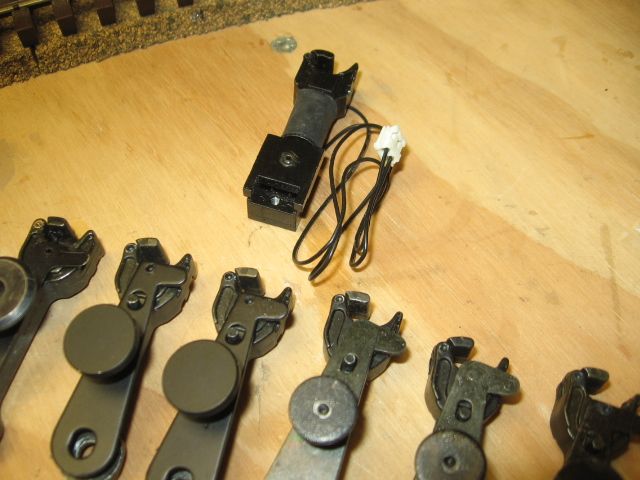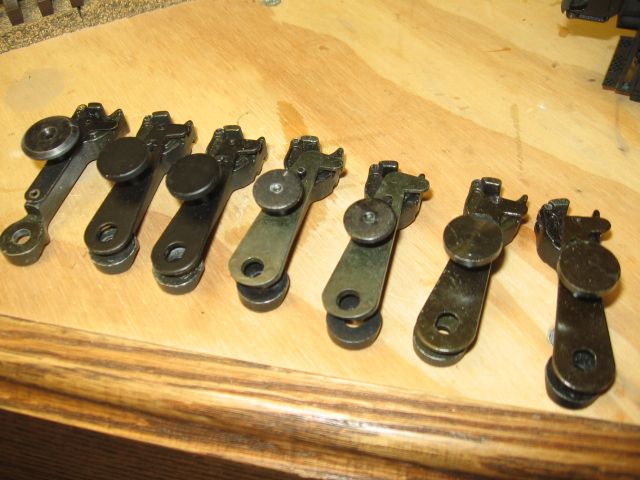I have some K Line cars from the 1990s (P&G set), and I have had the worst time with the couplers on them over the years... s the K Line couplers don’t seem to want to open, or close properly, and even my newer K Line cars have pretty stiff couplers compared to their Lionel counterparts. It seems to me like the couplers uncoupling disks are so close to the center rail that they don’t have enough throw to open or close a coupler when coupling? I vaguely recall coming across some talk of the tension of the springs in that eras couplers being too tight but I am not sure if that is the issue. Anybody else have this issue? I’m still running on tubular track, and I mostly couple and uncouple by hand... it’s not a bid deal since I largely just leave the couplers closed and let other cars couplers handle the hookups when switching but it just bugs me...
Replies sorted oldest to newest
Those flimsy coupler armatures are a problem for my K-Line stuff also. I have bent some of them a little to improve the performance slightly, but they still aren't great.
I have some K-Line cars and locomotives with the same issues. There are some conversion armatures available but I have not tried these (yet). I have a weak armature spring on my S2 shifter that I have a rubber band keeping it tight. I was not sure the conversion kit would fit the S2.
Without use of photos, I'll try to describe some of my solutions based on my observations.
First off as a side note, standard procedure of my layout, is I drill out all rivets on nearly all rolling stock and reattach truck sets with a truss screw and a lock nut. It is the looseness of the rivet mounted trucks that is a major cause of derailments. Of course, this procedure also makes it very easy to work on truck repairs as all I have to do is unscrew the truck.
Now on to coupler armatures. Pulling out the armatures on K-Line cars can be a little challenging as the "V" split mounting is wider than the Lionel one. Trying to pop them free from the bottom using a flat head screw driver can sometimes cause them to break. An advantage to having the truck set loose, is that you can also push down on the top of that rear mounting of the armature... the "V" split part.
Directly above the part of the armature where the metal thumbtack is inserted, there's a guide piece that keeps the armature centered. The very top of this part has a protrusion - something of an upside down "L", or like the handle of an umbrella. Cut that protrusion off. This is much easier having the truck loose than mounted to the car. You could carefully use a razor blade or X-Acto knife. Or even a Dremel with a small grinding bit. There's not enough play in this part, so when you uncouple the car over a UC track, sometimes it wants to pull the whole armature loose: More of a occurrence with the die cast K-Line trucks over the plastic one. Once I have cut that part off, I have found the K-Line trucks couple and uncouple better over UC tracks.
YES, I agree I do think the plastic is either thicker or stiffer on the plastic K-Line coupler armatures. For rolling stock that comes uncoupled easily, I've gotten real good at using a BIC lighter to heat up the plastic and give it a bend upward, thus keeping the cars from coming uncoupled on their own, yet still allowing usual operation over a UC track. BUT that is an acquired skill, because it's very easy to melt other areas (like the knuckle pin) of the plastic armature, thus ruining it. A small rubber band is an easy fix here also. I have found bags of small black rubber bands in the hair accessories section of most dollar type stores.
There are people on this forum who think because parts look similar, you can easily use one brand of part on another brand train. WRONG... not without some tinkering. The coupler knuckles are different between Lionel and K-Line, as are the diameter of the rivets used to hold the knuckles to the truck.
The molded-in "spring" protrusion on the K-Line knuckle (on the K-Line PLASTIC truck sets) is shorter but thicker than that of the Lionel plastic knuckle on their plastic type trucks. BOTH are prone to breaking. But sometimes the broken K-Line one will hinder operation of the knuckle. So pop out the knuckle rivet using a narrow small screwdriver, and remove the knuckle and shake free the broken plastic "spring." Then reassemble. You won't have the self-springing function of the knuckle, but it will open and close much better. Again, some of these fixes are much easier done having the truck set loose from the train car.
As a side note here, I've had broken plastic coupler "springs" on both K-Line and LTI-era Lionel cars. And yet I have MPC made Lionel cars, that are now 40-50 years old, and the plastic knuckles still spring open just as when they were new. So that says to me, there's been a change in the composition of the Delrin plastic used to make these parts. Also says to me, that MPC stuff gets singled out for a lot of unjustified criticism.
On the topic of the K-Line conversion coupler kits. I have a few still sealed in their bags. The problem with those is the knuckle pin on the armature is too thick, and so it doesn't engage with knuckle without slamming the train car into another train car. The fix on those is to file down one side of the knuckle pin on the armature itself, so that it properly engages the coupler knuckle. This was also the case with early made K-Line cars that came with the metal coupler armature. A change to this piece was made later on.
On the topic of the S-2 switcher. The rubber band fix is probably the easiest fix for those couplers. I've done that too. Those coupler parts have long been unavailable from parts dealers. You can still find couplers for the K-Line MP-15 diesels (which would work on the S-2, but are MUCH longer and will stick out more), but not for the S-2 or the Alco FA's. You might be able to use one of the K-Line metal armature conversion kits... I've never tried that one. You most likely still have to file down the knuckle pin as I mentioned above.
On the topic of UC tracks. For whatever reason, I've discovered the center disc inside the red plastic piece on the K-Line 027 uncoupling tracks is higher than that of a Lionel made 027 UC track. And the postwar Lionel ones are even better. What I am saying, is that there is a little more space between the bottom of the metal thumbtack on the train car, and the top of the uncoupling track. That just allows for better uncoupling. I also as standard procedure, rewire all my UC tracks (before putting them into the layout) so that they operate from auxiliary power rather than track power. This way I can set the voltage to the UC tracks for optimal operation.
As another side note, I think the trucks used for the K-Line Train-19 series of cars were the very best ones made by K-Line. I've never had any problems with those. No zinc rot either (at least as of date). I believe these were the trucks later used again by RMT on their first incarnation as a company. Although since there have been some posts on these RMT trucks crumbling (and some K-Line Classic type trucks too), obviously there were some inconsistencies in the batch material used to manufacture these trucks at Sanda Kan. That, I suppose, is one advantage of plastic trucks.
Thanks for all the advice everyone... now I need to take a closer look at my Kline stock and sus out what precisely is up with it.
Interestingly, I noticed there is a definite difference between the way k line mounted it’s trucks on the Boxcar and Covered Hopper on my particular set. My hoppers have the trucks attached to the body not with rivets but screws. I tightened down the screws on one of the cars, in an attempt to maybe get the tab of the electro couplers more space between it and the third rail. That didn’t do anything for coupling, but it did make it far less wobbly on the tracks, at the cost of greatly increasing its rolling resistance. Doesn’t seem to have affected tracking otherwise, in spite of the trucks not being as easy to pivot, interestingly. I may run it like that for a while before putting it back to its original state, and see if it makes any other difference.
Oddly, I’ve never had trouble with the couplers on my K Line S2, which is probably the most reliable locomotive I own.
Most of my other, late production K Line cars have the Die-Cast trucks & couplers, which besides being pretty good looking are much beefier than my Lionel rolling stock, which can make smooth coupling tricky, you have to give them a good jolt. They seem to have a stiffer spring than Lionel cars, in line with the heavier couplers.
If I, or others, need warm plastic up to make it easier to manipulate, I suggest boiling it in water. You can get things very hot in water without worrying about burning the plastic... that’s a technique I’ve used when working on cleaning up some toys I’ve collected that needed to be cleaned up and specifically for getting rid of leaking plasticizers. Different plasticizer leaking might be behind what causes differences in brittleness in delrin, for cheaper plastics it can be particularly bad and variable. I’ve handled toys from the same brand & time period that for a variety of reasons aged very differently, with some getting the dreaded stickies and others going totally rock hard. With the differences in the lives of rail cars and between time period and brand it’s no surprise that coupler spring issues are all over the place in terms of occurrence.
A lot of 1990's train hardware has changes. Electro-couplers, 2" in length or smaller seem a good replacement.


Most of these couplers were from diesels, and locomotives, that were upgraded to TMCC, which had electro-coupler function.




